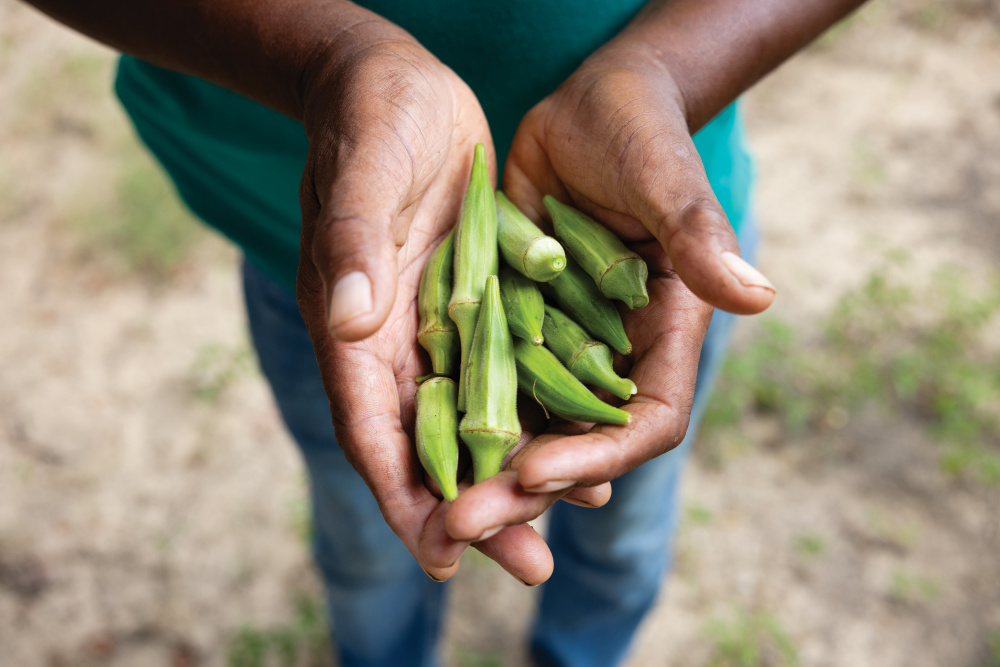Many of Mississippi’s citizens struggle with food insecurity and hunger. To combat this, Mississippi’s Department of Agriculture and Commerce (MDAC) partnered with local food banks across the state to launch the Local Food Purchase Assistance Cooperative Agreement program (LFPA). The program began through a cooperative agreement between the United States Department of Agriculture and MDAC in 2022 and is designed to help connect local farmers and food banks with the goal of increasing distribution of food to those who need it most.
“The LFPA program marks the first time that food banks have worked directly with MDAC to secure locally produced food for the communities we serve,” says Cassandra Mobley, chief operating officer of Mississippi Food network, a nonprofit organization launched in 1984.
The network is based in Jackson and serves 56 counties in central Mississippi. Two other food banks, Feeding the Gulf Coast and Mid-South Food Bank, are also involved in the LFPA program and address the needs of other parts of the state. The program was developed thanks to coordinated efforts by MDAC and the relevant food banks.
“We’ve been able to pivot and adapt the program to better serve the communities and also to build relationships with local producers,” Mobley says.

Farmers Are the Program’s Linchpin
The program has yielded success stories all over the Magnolia State.
Near Greenwood, James Brewer has been growing vegetables since his retirement in 2007 and has grown his farm from 1 acre to more than 7 today. Brewer grows tomatoes, green peas, cucumbers, squash and okra. MDAC’s partnership with local food banks has given Brewer an avenue to support his community through his produce. He is dedicated to bringing fresh, healthy, affordable food to those less fortunate around him in a variety of ways.
“I work with MDAC to increase food access in underserved communities, delivering fresh vegetables to elderly families that cannot drive,” Brewer says. “I sell produce at my farm and at farmers markets. I accept WIC vouchers, senior citizen vouchers and EBT cards. I have field days in order to convince other citizens to grow healthy vegetables; I show them how to grow sustainable vegetables.”
Mobley tells the story of James Gregory, a farmer from south Rankin County.
“Gregory donated product to the food bank for years in small amounts, whenever he was unable to sell the product through his normal channels,” she explains. Gregory also put MDAC in contact with several of his fellow farmers; those connections led to a substantial increase in fresh food available for the program. Mobley says that discussions with MDAC led Gregory to “tailor his planting to meet the needs of the food bank.”
Mike Pepper and his wife, Jenny, grow blueberries on Bowie Creek Orchard, their Jefferson Davis County farm.
“While the blueberry harvesting season is short, year-round you can still obtain a freshly frozen product that retains all the goodness – and nutritional benefits – of a fresh blueberry at harvest,” Pepper says.
Pepper has only recently become involved with the LFPA program, but he has already witnessed its benefits and the joyful reactions firsthand.
“Many of our deliveries are made directly to people either on the front line of distribution or the actual recipients,” he says. “It has been very fulfilling to see the glow on their faces when we bring this new or rarely used product.”

Everybody Wins
The program’s primary goal is to get nutritious food to the communities who might not otherwise have access to fresh, locally sourced foodstuffs.
“The addition of fresh local food for the families who depend on the charitable food system to supplement their diets is groundbreaking,” Mobley says. She emphasizes the additional support that the LFPA program provides for local producers to grow their businesses. These partnerships have empowered MDAC to work with a variety of producers across the state. And the program’s future looks bright.
“As we develop these relationships, the farmers learn more about how the food bank operates,” Mobley says, adding that she anticipates even more Mississippi farmers to become involved in the program.
“The Mississippi Food Network’s mission statement is to change lives by fighting hunger today and feeding hope for a healthier tomorrow,” Mobley says. “And the LFPA program is a vital component of that mission.”
See more: Choctaw Fresh Produce Grows an Organic Movement in Mississippi
Fantastic Food Banks
Three food banks are enrolled in the Local Food Purchase Assistance Cooperative Agreement program through Mississippi’s Department of Agriculture and Commerce (MDAC). Learn more about each food bank and how they help feed the community.
Mississippi Food Network
The Mississippi Food Network (MFN) distributes 1.5 million pounds of food, which feeds 150,000 Mississippians every month or more than 1.8 million hungry people each year. Every $50 donated creates 300 meals. Volunteers can help at various distribution events throughout the state. Visit msfoodnet.org to learn more about how to help or enter your ZIP code to find food through their programs.
Feeding the Gulf Coast
For more than 40 years, Feeding the Gulf Coast, formerly known as Bay Area Food Bank, has been fighting hunger in Mississippi, Alabama and the panhandle of Florida. For every dollar donated, Feeding the Gulf Coast provides five meals to local hungry people. To learn more, visit feedingthegulfcoast.org.
Mid-South Food Bank
Mid-South Food Bank distributes wholesome and nutritious foods to local hungry people in Mississippi. Mid-South Food Bank currently distributes an average of 2.5 million meals a month through its network of 300 partner agencies in 12 counties in West Tennessee, 18 counties in north Mississippi and one county in Arkansas. Visit midsouthfoodbank.org to learn more about volunteer options or to find food.